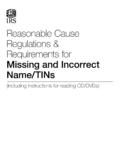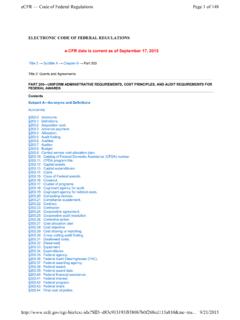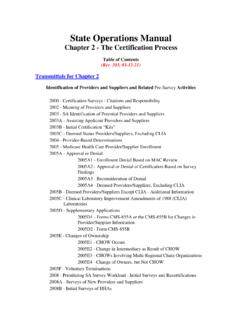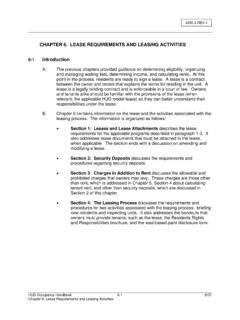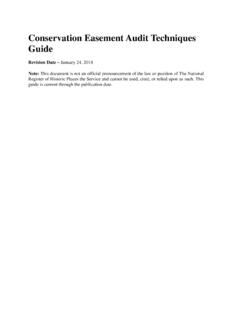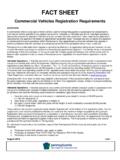Transcription of 14 CFR (FAR) Part 43 and 91; General Aviation Maintenance ...
1 Federal Aviation Administration Aviation Rulemaking Advisory Committee Air Carrier/ General Aviation Maintenance Issue Area General Aviation Maintenance Working Group Task 1 14 CFR Part 43 and 91 Task Assignment [4910-13] DEPARTMENT OF TRANSPORTATION Federal Aviation Administration Aviation Rulemaking Advisory Committee; General Aviation Maintenance Working Group AGENCY: Federal Aviation Administration (FAA), DOT. ACTION: Notice of establishment of General Aviation Maintenance Working Group. SUMMARY: Notice is given of the establishment of the General Aviation Maintenance Working Group of the Aviation Rulemaking Advisory Committee (ARAC). This notice informs the public of the activities of the ARAC on air carrier/ General Aviation Maintenance issues. FOR FURTHER INFORMATION CONTACT: Mr. Frederick J. Leonelli, Assistant Executive Director for Air Carrier/ General Aviation Maintenance Issues, Aviation Rulemaking Advisory Committee, Flight Standards Service (AFS-300), 800 Independence Avenue, SW.
2 , Washington, 20591, Telephone: (202) 267-3546; FAX: (202) 267-5230. SUPPLEMENTARY INFORMATION: The Federal Aviation Administration (FAA) has established an Aviation Rulemaking Advisory Committee (ARAC) (56 FR 2190, January 22, 1991; and 58 FR 9230, February 19, 1993). One area the ARAC deals with is air carrier/ General Aviation Maintenance issues. These issues involve mechanic certification and approved training schools outlined in parts 65 and 147 and the Maintenance standards for parts 23, 25, 27, 29, 31, 33, and 35 aircraft, engines, propellers, and their component parts and parallel provisions in parts 21, 43, 91, 121, 125, 127, 129, 133, 135, and 137 of the Federal Aviation regulations (FAR), which are the responsibility of the FAA Director, Flight Standards Service. Task Specifically, the working group's task is the following: Review Title 14 Code of Federal regulations , parts 43 and 91, and supporting policy and guidance material for the purpose of determining the course of action to be taken for rulemaking and/or policy relative to the issue of General Aviation aircraft inspection and Maintenance , specifically section , part 43, and Appendices A and D of part 43.
3 In your review, consider any inspection and Maintenance initiatives underway throughout the Aviation industry affecting General Aviation with a maximum certificated takeoff weight of 12,500 pounds or less. Also consider ongoing initiatives in the areas of: Maintenance recordkeeping; research and development; the age of the current aircraft fleet; harmonization; the true cost of inspection versus Maintenance ; and changes in technology. If deemed appropriate, draft for ARAC a notice of proposed rulemaking for the task proposing new or revised requirements, a supporting economic analysis and other required analysis, advisory and guidance material, and any other collateral documents the working group determines to be needed. Reports A. Recommend time line(s) for completion of the task, including rationale, for consideration at the meeting of the ARAC to consider air carrier/ General Aviation Maintenance issues held following publication of this notice. B. Give a detailed conceptual presentation on the task to the ARAC before proceeding with the work stated under item C below.
4 C. Give a status report on the task at each meeting of ARAC held to consider air carrier/ General Aviation Maintenance issues. The General Aviation Maintenance Working Group will be comprised of experts from those organizations having an interest in the task assigned. A working group member need not necessarily be a representative of one of the member organizations of ARAC. An individual who has expertise in the subject matter and wishes to become a member of the working group should write the person listed under the caption FOR FURTHER INFORMATION CONTACT expressing that desire, describing his or her interest in the task, and the expertise he or she would bring to the working group. The request will be reviewed with the Assistant Chair of the ARAC for air carrier/ General Aviation Maintenance issues and the Chair of the General Aviation Maintenance Working Group, and the individual will be advised whether or not the request can be accommodated. The Secretary of Transportation has determined that the formation and use of the ARAC are necessary in the public interest in connection with the performance of duties imposed on the FAA by law.
5 Meetings of the ARAC to consider air carrier/ General Aviation Maintenance issues will be open to the public except as authorized by section 10(d) of the Federal Advisory Committee Act. Meetings of the General Aviation Maintenance Working Group will not be open to the public, except to the extent that individuals with an interest and expertise are selected to participate. No public announcement of working group meetings will be made. Issued in Washington, DC, on September 23, 1994 /s/ Frederick J. Leonelli Assistant Executive Director for Air Carrier/ General Aviation Maintenance Issues Aviation Rulemaking Advisory Committee Department of Transportation Federal Aviation Administration MAY 28 1900 Ms. Sarah MacLeod Assistant Chair for Air Carrier/ General Aviation Maintenance Issues Aeronautical Repair Station Association Alexandria, VA 22314 Dear Ms. MacLeod: 800 Independence Ave .. Washington, 20591 This is in follow-up to my letter of March 20, 1996, to Mr. William C.
6 Keil, the then Acting Assistant Chair, Aviation Rulemaking Advisory Committee (ARAC), regarding the revised task statement submitted by the General Aviation Maintenance Working Group. The Federal Aviation Administration has reviewed the proposal and rewritten the task statement to read: Review Title 14 Code of Federal regulations , parts 43 and 91, and supporting policy and guidance material for the purpose of determining the course of action to be taken for rulemaking and/or policy relative to the issue of General Aviation aircraft inspection and Maintenance . Specifically, the working group is to focus on the following areas: 1. Part 43, Appendix A: Review and update all major alterations, major repairs, and preventative m~ntenance items. 2. Part 43, Appendix B: Review to identify harmonization issues in regards to Form 337 requirements; explain the scope and detail of the 8130-3 tag; and revise the Maintenance release (yellow tag) statement. 3. Part 43, Appendix D: Expand the scope and detail of this appendix to include rotorcraft, balloons, and gliders.
7 4. Part 43, Appendix E and F: Analyze and review these two appendices for accuracy. Taking into cOllsideration the requirements of part 121, make recommendations regarding the use of Advisory Circulars as the site to publish data and procedures subject to change due to technical upgrades. 5. Part 91, Subpart E: Examine alternative inspection programs for General Aviation aircraft (not for hire), antique aircraft, and restricted category aircraft (aerial applicators, pipeline patrol, fire fighting, and war birds). If ARAC determines rulemaking documents or advisory circulars are appropriate, such documents should be developed by ARAC, along with proper justification and any legal and economic analysis. The original and the working group's proposed revision are enclosed for comparison. The time and consideration being given to these issues by the members of the General Aviation Maintenance Working Group is greatly appreciated. Sincerely, ~~ CJry,~~ .~ m Anthony j: Broderi~k 6 *'".
8 Associate Administrator for Regulation and Certification Enclosures cc: EXCOM Members 2 Recommendation Letter September 24, 2001 HAND DELIVERED Mr. Thomas E. McSweeny Associate Administrator for regulations and Certification Federal Aviation Administration 800 Independence Avenue, Room 1000W Washington, 20591-0004 RE: Aviation Rulemaking Advisory Committee for Air Carrier and General Aviation Maintenance Issues Recommendations on Clarification of Major/Minor Repairs or Alterations Task Recommendations on General Aviation Maintenance Task Dear Mr. McSweeny: Please find enclosed technical reports and draft advisory circulars from the above referenced ARAC regarding the noted tasks. These documents are being forwarded to the FAA for an appropriate disposition by the agency. In addition to the recommendations contained in the reports and advisory material, the ARAC requests that the following issues be considered during the FAA's deliberations: 1. Before the FAA issue final documents as a result of the attached reports and advisory circulars it ensures that any changes are fully coordinated so that there will be unifo~ application, interpretation and enforcement.
9 2. The definition of "alteration" in the draft advisory circular entitled "Repair and Alteration Data" reflect changes other than those to an "original" product. You may consider changing the word "original" to "appropriate." In other words, please . ensure that an aircraft can be changed from one altered state to another, not just from an "original" state to an altered state. 3. When finalizing the definition of major alteration by the FAA, the agency must ensure that all approved manufacturers are included in the product's "specification." For example, appliances are included in the specifications of the aircraft, aircraft engine or propeller. Therefore a change to an appliance would only be major if it was not incorporated in the specification of the product by the FAA-approved design and/or production authorization holder. The same would hold true for a Parts Manufacturer Approval holder who is supplying components to a type or production certificate holder (which would include their parts in the specifications of the product).
10 ---------------------------------------- --------Mr. Thomas A. McSweeny September 24, 2001 Page 20f2 4. The concerns expressed by Transport Canada on page three of the General Aviation Working Group's technical report are limited to the confusion that could be created between the definition of major repair and major alteration contained in Part 1 and the list of major repairs and alterations contained in the Appendix to Part 43. Transport Canada is afraid that an action may be a minor repair under the definition while still being listed in the Appendix. Additionally, they are concerned with the recommended change to the definition of major repair in that the complexity of the repair (Le., the difficulty of the work that needs to be done by the Maintenance technician) does not require the technical or substantiating data to be approved in the Canadian system. Therefore, a repair that would be minor in Canada may be considered major in the United States. They are concerned about the confusion created when different definitions are developed by international partners.










